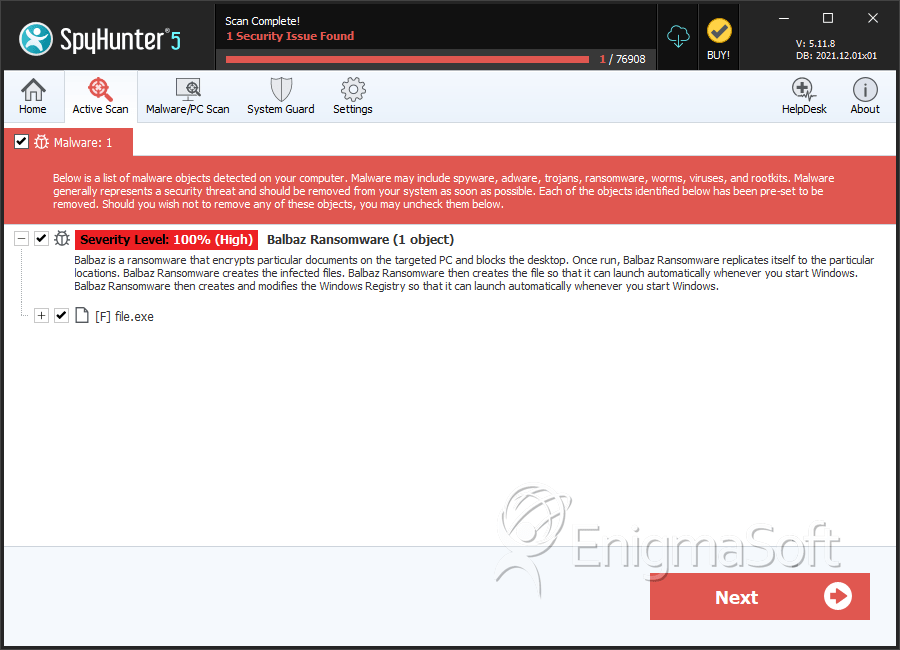Balbaz Ransomware
The Balbaz Ransomware is an encryption ransomware Trojan. Like most ransomware Trojans, the Balbaz Ransomware is designed to take the victim's files hostage, to ask for the payment of a ransom. The Balbaz Ransomware is known is known to attach the '.WAmarlocked' extensio nto filenames and its file marker may be used as a basis for its name by other cybersecurity developers. Thus, the Balbaz Ransomware may be listed on malware databases under the alias WAmarlocked Ransomware. To do this, the Balbaz Ransomware uses a strong encryption algorithm to make the victim's files inaccessible. The creators of the Balbaz Ransomware then deliver a ransom note, threatening to withhold the decryption key necessary to recover the affected files until the victim pays a certain amount of money. This is a tactic used by numerous ransomware Trojans active today. Computer users should take steps to safeguard their data preemptively since the data encrypted by the Balbaz Ransomware attack is not recoverable without the decryption key, which the con artists hold in their possession.
Table of Contents
The Balbaz Ransomware is Another HiddenTear-Based Threat
The Balbaz Ransomware is a variant of Hidden Tear, an open source ransomware platform that was first released to the public in August of 2015. Since its initial release, the Balbaz Ransomware has spawned countless variants. The easy availability of an effective ransomware engine meant that, since Hidden Tear's release, anyone with some basic computer skills would be able to create their own harmful and effective encryption ransomware Trojan practically. The Balbaz Ransomware may be delivered using corrupted email messages. The victims will receive a spam email message that includes a Microsoft Word document attachment. These messages will use misleading content to trick the victim into opening the attached file. When the victim downloads and opens the corrupted file, the Balbaz Ransomware will be downloaded and installed on the victim's PC.
How the Balbaz Ransomware Attack is Carried Out
The Balbaz Ransomware will create an index file that contains information on all the files targeted in the Balbaz Ransomware attack. The Balbaz Ransomware will target the files generated by the user, typically looking for media files such as photos, music and video, as well as all files associated with commonly used software such as Microsoft Office, Adobe Photoshop and many others. Apart from encrypting the victim's files using a strong encryption algorithm, the Balbaz Ransomware also will delete Shadow Volume copies of the affected files, to make it even more difficult to recover the affected files. The Balbaz Ransomware will deliver its ransom note once the victim's files have been encrypted. The Balbaz Ransomware's ransom note is contained in a text file named 'READ_IT.txt' dropped on the infected computer's desktop. This ransom note is modeled after the ransom note used by WanaCrypt0r, a high profile ransomware Trojan that was released earlier in 2017 and claimed countless of victims, receiving widespread media coverage. The Balbaz Ransomware's ransom note is delivered in a program window named 'Ransomware BALBAZ 1.00.' This ransom window directs victims to a payment portal hosted on the Dark Web, requiring TOR to connect. The ransom amount used by the Balbaz Ransomware will vary, but it may cost between 2000 and 3000 USD. Malware experts strongly advise computer users to avoid paying the Balbaz Ransomware ransom.
Dealing with the Balbaz Ransomware Attack
Computer users should avoid paying the Balbaz Ransomware ransom for the following reasons:
- Paying the Balbaz Ransomware ransom allows the people responsible for the Balbaz Ransomware attack to continue creating and releasing new threats by financing their activities.
- Victims that pay the Balbaz Ransomware ransom may be targeted for additional attacks since they've shown once that they're willing and capable of paying these ransoms.
- The people responsible for these attacks may ignore the victim, ask for additional money, or deliver decryption keys that don't work.
The best protection against ransomware Trojans like the Balbaz Ransomware is to have file backups on an external memory device or the cloud. Having the ability to recover your files quickly and easily nullify the attack, preventing the con artists from asking for a ransom amount.
SpyHunter Detects & Remove Balbaz Ransomware

File System Details
| # | File Name | MD5 |
Detections
Detections: The number of confirmed and suspected cases of a particular threat detected on
infected computers as reported by SpyHunter.
|
|---|---|---|---|
| 1. | file.exe | c9d10a6e67ac7f872591e4a6d29d5506 | 0 |


Submit Comment
Please DO NOT use this comment system for support or billing questions. For SpyHunter technical support requests, please contact our technical support team directly by opening a customer support ticket via your SpyHunter. For billing issues, please refer to our "Billing Questions or Problems?" page. For general inquiries (complaints, legal, press, marketing, copyright), visit our "Inquiries and Feedback" page.